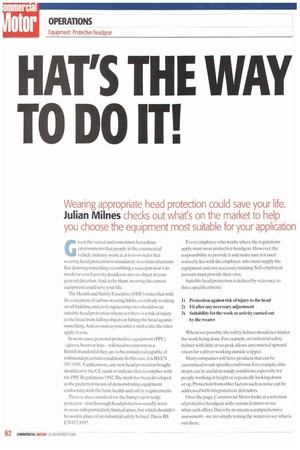HATS THE illtAlt TO DO 11!
Page 62

If you've noticed an error in this article please click here to report it so we can fix it.
Wearing appropriate head protection could save your life. Julian Miines checks out what's on the market to help you choose the equipment most suitable for your application
Given the varied and sometimes hazardous environments that people in the commercial vehicle industry work in. it is no wonder that wearing head protection is mandatory in certain situations. But donning something resembling a saucepan won't do much for you if gravity decides to aim an object in your general direction. And, to be blunt. wearing the correct equipment could save your life.
The Health and Safety Executive (HSE) states that with the exception of turban-wearing Sikhs. everybody working on all building and civil engineering sites should wear suitable head protection whenever there is a risk of injury to the head from falling objects or hitting the head against something. And as soon as you enter a such a site, the rules apply to you.
In most Cases, personal protective equipment (PPE) — gloves, boots or hats— will need to conform to a British Standard if they are to he considered capable of withstandign certain conditions. In this case, it is BS EN 397:1995. Fit rthc rmore,any new head protection bought should carry the CE mark to indicate that it complies with the PPE Regulations I992.The mark has been developed as the preferred means of demonstrating equipment conformity with the basic health and safety requirements.
There is also a standard for the bump cap orscalp protector — less thorough head protection usually worn in areas with particularly limited space, but which shouldn't be used in place of an industrial safety helmet.lbis is BS EN 812:1997. Every employee who works where the regulations apply must wear protective headgear. However. the responsibility to provide it and make sure it is used correctly lies with the employer, who must supply the equipment and any necessary training. Self-employed persons must provide their own.
Suitable head protection is defined by reference to three specific criteria: 0 Protection against risk of injury to the head 2) Fit after any necessary adjustment 3) Suitability for the work or activity carried out by the wearer Whenever possible, the safety helmet should not hinder the work being done. For example, an industrial safety helmet with little or no peak allows unrestricted upward vision fora driver working outside a tipper.
Many companies will have, products that can he customised to suit specific conditions.For example. chin straps can be useful in windy conditions,especially for people working at height or repeatedly looking down or up. Protection from other factors such as noise can be addressed with integrated ear defenders.
Over the page, Commercial Motor looks at a selection of protective headgear with various features to see what each offers.This is by no means a comprehensive assessment—we are simply testing the waters to sec what is out there.




































































































































































































































